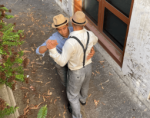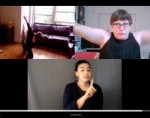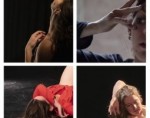Xochii de la Noche at Queer Mvmnt Fest
by Kara Nepomuceno
I want to surprise myself when I’m dressing for a queer event. I used to fuss with layers and belts, aiming for the illusion of slim femininity. But tonight, for Disco Riot’s inaugural Queer Mvmnt Fest, I embrace ease. What if I wore this black summer dress backwards, so the neckline felt comfortable and high? What if I wore this loose white bomber and let my stomach hang out? And as I step back, head tilting in the mirror—does it look queer?
I’m arranging the bomber as a black-out descends in City Heights Annex, a small indoor/outdoor theater. It’s convertible by a rolling garage door, which partitions it from the library and recreation center adjacent. Outside, kids are playing and shouting in the late-setting sun. Here, the clacking of heels lets us know the night’s beginning. A house beat thrums through the annex—a Lana Del Rey remix titled “High by the Beach.”
Xochii de la Noche describes themselves as a Latine “performer, flow artist dancer, DJ, glitch artist, and producer just to name a few.” In delicate stilettos they glide, breezing forward with two white silk fans at their side. De la Noche’s gem-encrusted bikini top glitters, catching the undersea light. Their shoulders roll back as they lift their fans into an S-curve, twirling them in a figure eight.
The swirling props resemble those used in Chinese fan dances, with stiff ribs sheathed by smooth fabric that cascades to the floor. The fans differ from the bouncy, feathered versions used in Burlesque. The combination of burlesque movement and silk fan props creates what de la Noche describes as a “silk fan and neo-burlesque” performance. The program also dubs it an ode to the “best summer day in Long Beach, CA”. It is the only performance by a femme of color for the evening, and the only piece using flow arts.
de la Noche waves the fans to their front, soft stomach undulating over white crepe skirt. A hint of bejeweled blue bikini glints through. As they turn away from the audience, they slip the mist-like skirt to the ground.
“I don’t need your money,” the music croons, “to get what I want.”
de la Noche steps lightly backwards and in response, the fans ripple outwards, two ivory rivers. The fans swoop downwards and rest on their ground, their soft fabric pools like milk. Hands freed, the artist spirals to the floor to rest on their side. Their smile never wavers; they extend their leg to the sky and float their fingers down their thigh.
Standing now, back facing the audience, they slowly untie the strings of their top piece. They bend forwards flirtatiously and pick up the fans again, wielding the cloud-like lengths forward and back. Their fans catch the aquamarine and violet light, designed by Taylor Olson.
The fans flutter side to side, teasing. They part to reveal sequined green pasties—shaped like marijuana leaves. The crowd laughs in delight as the artist spins and struts.
The work invites play and ease, twirling through multiple expectations this evening—whiteness, “contemporary” and “experimental” movement. It’s my impression that audiences expected something different. The crowd clapped and spilled out yessses, yet their affirmations seemed too quiet–better suited to the experimental and Western contemporary work that would follow.
The following performances took distinct shapes yet between them shared similar facets. Artists Avery Polster, Anna Brown Massey, Viktor De La Fuente, Jasmyn Hamblin, and Jay Carlon investigated grief, labor, and gender roles through physical tension, strong and virtuosic movement, and presence-filled pauses. They visited but rarely lingered in the playful lightness offered in de la Noche’s performance.
“Contemporary” or “experimental” works are often received in San Diego with quiet yet distant contemplation and nods. de la Noche’s performance disrupts those expectations, inviting warmer artist-audience interactions in performance. Notably, the festival’s organizational home, Disco Riot, is doing the same. Their ongoing Choreo & ___ series combines contemporary, movement-based art with activities like rock-climbing, roller-skating, and kickball.
In de la Noche’s hands, notions about queer movement are more fragile, swirling and spinning through the air like a fistful of feathers. They toss these expectations lightly before and behind themselves, and sometimes drop the veils entirely. In doing so they reveal their body, glittering, joyful, and always in motion.
As the artists reflect in their talk-back the next evening, queer movement is not a particular aesthetic or look; it does not belong to experimental or Western contemporary concert-dance alone. It’s more a series of choices, iterating the artist closer and closer to themselves, even if this bucks the norm.
Tonight, queer movement can mean shedding the tense muscularity, silent contemplation, and distant audiencing that can conceal one’s authentic expression. It can be the delight and surprise of flowing, of moving with ease and pleasure when and where it’s least expected.
Queer Mvmnt Fest was the first event of its kind on the unceded land of the Kumeyaay nation, working against several barriers, including a pandemic. I look forward to future iterations that continue to uplift queer BIPOC artists in dance, flow arts, and other movement forms.
At the end of the evening, I fold my white bomber carefully away. I am reminded that I don’t need to wear a certain type of clothing or hairstyle to look queer. It’s not the shape or the type of clothing, but the ease, comfort, and delight it provides.
Queer Mvmnt Fest, City Heights Annex, June 24–27.
By Kara Nepomuceno
July 5, 2022










